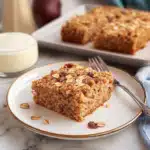After trying dozens of almond flour cookie recipes that turned out dry, crumbly, or bland, I was ready to give up. Every batch felt like a gamble. But I kept testing and tweaking until I landed on this one the recipe Almond Flour Chocolate Chip Cookies I now make on repeat.

These cookies come out perfect every single time. Think chewy centers packed with gooey chocolate, crisp golden edges, and a soft bite that melts in your mouth.
It’s a tried-and-true favorite that’s naturally gluten-free, grain-free, and made with simple ingredients. Whether you’re baking for a special diet or just want a seriously good cookie, this is the one to save and share.
Table of Contents
Ingredients Needed and Why They Matter
Understanding why each ingredient matters will help you get the best texture and flavor every time. These cookies aren’t just good because of what’s in them, but because of how those ingredients work together.
Blanched Almond Flour
Use finely ground blanched almond flour, not almond meal. It creates a smooth dough and gives the cookies their soft, chewy texture. Almond meal can make them gritty or too dense.
Butter or Coconut Oil
Softened butter gives the cookies a rich flavor and a chewy center. If you use melted butter, expect crispier edges. Coconut oil is a great dairy-free option and adds a slight sweetness.
Brown Sugar or Coconut Sugar
These sugars keep the cookies moist and add depth of flavor. Brown sugar gives that classic caramel note while coconut sugar keeps things refined sugar-free without losing richness.
Egg and Cornstarch
Since almond flour doesn’t have gluten, these act as binders. The egg holds everything together and adds moisture. Cornstarch helps keep the cookies from spreading too much while adding a light, soft texture.
Step-by-Step Instructions
Follow these easy steps to get cookies that are perfectly golden on the edges with soft, chewy centers.
Step 1: Preheat your oven and prep the pan
Set your oven to 350 degrees Fahrenheit. Line a baking sheet with parchment paper so the cookies bake evenly and don’t stick.
Step 2: Mix the wet ingredients
In a large mixing bowl or the bowl of a stand mixer, add the softened butter, coconut oil, and brown sugar. Beat until the mixture is smooth and creamy. Add the vanilla extract and eggs. Mix again until fully combined and the mixture looks light in color.
Step 3: Add the dry ingredients
Sprinkle in the baking soda and salt. Mix briefly. Then add the almond flour one cup at a time, beating well after each addition. This helps the flour blend evenly and gives the dough structure.
Step 4: Fold in the extras
Using a wooden spoon or spatula, fold in the chocolate chips and chopped walnuts. Mixing by hand keeps the dough from getting overworked.
Step 5: Chill the dough
Cover the bowl and place it in the fridge for at least 30 to 60 minutes. This step helps control spreading during baking and makes the dough easier to handle.
Step 6: Shape and space the cookies
Scoop the dough into tablespoon-sized rounds. Place them on the lined baking sheet, leaving about 3 inches between each cookie to allow room for spreading.
Step 7: Bake and cool
Place the baking sheet in the oven and bake for 11 to 13 minutes. Look for golden edges and slightly soft centers. Remove from the oven while they still look a little underbaked. Let them rest on the baking sheet for 5 minutes before transferring to a wire rack to cool completely.
Enjoy warm or let them cool for that perfect balance of chewy middle and crispy edge. These cookies are best eaten the same day but stay delicious for days if stored right.

Pro Tips for Perfect Cookies
These little tricks make a big difference. Try a few and you will see more consistent, bakery-style results.
Pull them early
Take the cookies out when the edges are golden and the centers still look slightly soft. The hot pan will finish the bake and that keeps the centers chewy.
Measure almond flour the right way
Spoon the flour into your measuring cup and level it with the back of a knife. Do not scoop directly with the cup or you will pack in too much flour and end up with dense cookies.
Chill the dough
Cool dough chills for at least 30 minutes. Cold dough spreads less and holds shape better, giving you thicker cookies with a gooey middle.
Tap the pan after baking
Right after removing the tray from the oven, set it on a heat-safe surface and give the pan a gentle tap. This lets trapped air escape and helps the cookie interiors stay tender.
Watch butter temperature
If you want chewy cookies, use softened butter. If you want crisp edges, use melted butter. Room temperature butter should give a balanced chew and spread.
Use a thermometer if your oven is old
Oven temps can be off by a lot. An inexpensive oven thermometer helps you bake at the true temperature for reliable results.
Don’t overmix once the flour goes in
Stir just until the almond flour and other dry bits are blended. Overworking the dough can change the texture and make cookies tougher.
Add a tiny cornstarch boost
If you want extra soft, pillowy cookies, add a teaspoon of cornstarch to the dry mix. It helps with structure and a tender bite.
Space the dough well
Leave about three inches between scoops. Almond flour cookies can spread more than wheat ones, so give them room.
Try one or two tips at a time and see what works best with your oven and ingredients.
The Ultimate Substitution Guide
Need to make swaps for dietary needs or pantry limits? These tested substitutions keep the cookies tasty and the texture just right.
For a dairy-free version
Use vegan butter sticks, organic palm shortening, or coconut oil instead of regular butter. All three work well but each gives slightly different textures. Vegan butter adds creaminess. Palm shortening creates a softer bite. Coconut oil brings a hint of sweetness and a more tender finish.
For a vegan version
Skip the egg and use a flax egg instead. Mix one tablespoon of flaxseed meal with three tablespoons of water. Let it sit for about five minutes until it thickens. This helps bind the dough and keeps everything from falling apart.
For refined sugar-free options
Coconut sugar can replace brown sugar in a one-to-one ratio. It has a deeper, slightly caramel-like taste. Maple syrup and honey are also good choices, though they change the texture. Reduce other liquids slightly if using these.
For nut allergies
This recipe is built around almond flour so a direct swap will change the result. Some readers have tried sunflower seed flour or oat flour but expect different textures. If you test this, make a half batch first.
For coconut oil substitutes
Use the same amount of butter instead. You may get a slightly crispier edge and a richer flavor.
For corn-free diets
You can skip the cornstarch or replace it with arrowroot powder in the same amount. This keeps the texture soft without using corn-based products.
These substitutions have been tested by home bakers and readers. They help keep the cookies flexible for almost any diet.

Flavor Variations and Add-Ins
Want to change it up? These easy variations keep the recipe exciting every time you bake.
Add some crunch
Mix in chopped walnuts or pecans for texture and a nutty flavor boost. Toasting the nuts before adding them makes them even more flavorful.
Try different chocolates
Use dark chocolate chunks for a richer taste or mini chips for a more even melt throughout the cookie. Milk chocolate works if you prefer something sweeter.
Make them double chocolate
Replace two tablespoons of almond flour with unsweetened cocoa powder. This gives the cookies a deeper chocolate flavor and pairs perfectly with dark chocolate chips.
Add dried fruit
Raisins, dried cherries, or chopped dates make a great addition if you want a bit of natural sweetness and chew.
Sprinkle sea salt on top
A light sprinkle of flaked sea salt right after baking brings out the chocolate flavor and gives a perfect sweet-salty finish.
Go festive with spices
Add a pinch of cinnamon or nutmeg to the dough for a warm, spiced twist. Perfect for holiday baking or cozy weather cravings.
Mix in trail mix or seeds
Try tossing in a handful of pumpkin seeds, sunflower seeds, or chopped dried fruit for a more rustic, hearty cookie.
Small changes like these can transform the base recipe into something brand new. It’s a great way to keep your cookie game fresh without starting from scratch.
Storage and Freezing Instructions
These cookies store well, and with a few simple steps, you can enjoy them fresh even days or weeks later.
Storing at room temperature
Once the cookies have completely cooled, place them in an airtight container. Keep them at room temperature and they’ll stay fresh for three to five days. If your kitchen runs warm, store them in a cooler pantry or cupboard to help maintain texture.
Freezing baked cookies
To freeze already baked cookies, let them cool fully first. Arrange them in a single layer on a baking sheet and place in the freezer for about an hour. Once frozen, transfer to a sealed freezer-safe bag or container. They’ll keep well for up to three months. When ready to eat, thaw at room temperature or warm them slightly in the oven for that just-baked feel.
Freezing the dough
You can also freeze the dough for later baking. Scoop it into tablespoon-sized portions and place them on a tray lined with parchment paper. Freeze the tray until the dough balls are solid, then store them in a zip-top freezer bag. When baking from frozen, add two to four extra minutes to the bake time without thawing.
These methods help you make a batch now and save some for later without losing that fresh-baked flavor or chewy texture.
Print
Almond Flour Chocolate Chip Cookies
- Total Time: 27 minutes
- Yield: 24 cookies 1x
Description
Soft, chewy almond flour chocolate chip cookies with gooey centers and crispy edges. Naturally gluten-free, easy to make, and perfect for clean-eating dessert lovers.
Ingredients
- 2 ½ cups blanched almond flour
- ½ cup softened butter or coconut oil
- ¾ cup brown sugar or coconut sugar
- 1 large egg
- 1 tsp vanilla extract
- ½ tsp baking soda
- ¼ tsp salt
- 1 tsp cornstarch (optional, for extra softness)
- ¾ cup chocolate chips
- ½ cup chopped walnuts (optional)
Instructions
- Preheat the oven to 350°F (175°C) and line a baking sheet with parchment paper.
- In a large bowl, beat together softened butter (or coconut oil) and sugar until smooth and creamy.
- Add in vanilla and egg. Mix until well combined.
- Stir in baking soda, salt, and cornstarch (if using).
- Add almond flour one cup at a time, mixing after each addition.
- Fold in chocolate chips and chopped walnuts.
- Cover the dough and chill for 30–60 minutes.
- Scoop tablespoon-sized balls of dough onto the prepared baking sheet, leaving 3 inches between each.
- Bake for 11–13 minutes until edges are golden and centers look slightly soft.
- Let cool on the sheet for 5 minutes before transferring to a wire rack.
Notes
Chill the dough to prevent spreading and use blanched almond flour for the best texture. For extra flavor, sprinkle sea salt on top right after baking.
- Prep Time: 15 minutes
- Cook Time: 12 minutes
- Category: Dessert
- Method: Baking
- Cuisine: American
Nutrition
- Serving Size: 1 cookie
- Calories: 95 kcal
- Sugar: 7 g
- Sodium: 10 mg
- Fat: 6 g
- Saturated Fat: 2 g
- Unsaturated Fat: 0.05 g
- Trans Fat: 0 g
- Carbohydrates: 10 g
- Fiber: 1 g
- Protein: 2 g
- Cholesterol: 0.1 mg
Why This Almond Flour Chocolate Chip Cookie Recipe Works
This recipe delivers on every level. It’s simple to make, uses everyday ingredients, and the results are unbeatable. You get perfectly chewy centers, crisp edges, and rich chocolate flavor in every bite. Whether you follow a gluten-free, grain-free, or refined sugar-free lifestyle, this cookie fits right in without sacrificing taste.
Tested dozens of times and loved by readers, this is the kind of recipe that becomes a go-to in your kitchen. It’s not just another almond flour cookie. It’s one you’ll come back to again and again.
Tried it? Drop a comment below and let others know how it turned out. Don’t forget to leave a star rating if you loved it.
Share your results on Pinterest or Facebook to inspire other home bakers.
Have you tried any fun add-ins or swaps? We’d love to hear your twist on this classic. Let us know in the comments.

FAQs
How to prevent cookies from falling flat?
Cookies often flatten when the dough is too warm or the butter is overly soft. Make sure to chill the dough for at least thirty minutes before baking. This helps the fat firm up and slows spreading. Measuring flour properly and using enough almond flour also helps hold the shape.
Why do my almond flour cookies fall apart?
Almond flour lacks gluten, which acts as a binder in traditional cookies. To solve this, the recipe uses egg and cornstarch to provide structure. If your cookies still fall apart, check your measurements and avoid skipping the chill time.
Is it better to bake with blanched or unblanched almond flour?
Blanched almond flour is the better choice for cookies. It is finely ground and has the skins removed, giving the dough a smoother texture and a lighter color. Unblanched almond meal contains skins and creates a denser, grittier cookie.
How to tell when almond flour cookies are done?
Look for golden edges and slightly soft centers. The cookies should look just underbaked in the middle. Let them rest on the baking sheet for five minutes after baking so they set properly without overcooking.
What should a person do before storing freshly baked chocolate chip cookies?
Always let cookies cool completely before storing. Place them in an airtight container and keep them at room temperature. If they’re still warm, the trapped steam can make them soggy.
What are some common almond flour cookie mistakes?
Some common issues include using almond meal instead of blanched flour, not chilling the dough, and overbaking. Other mistakes include measuring flour incorrectly or skipping the egg or binding ingredient. Always follow the steps closely for the best results.




